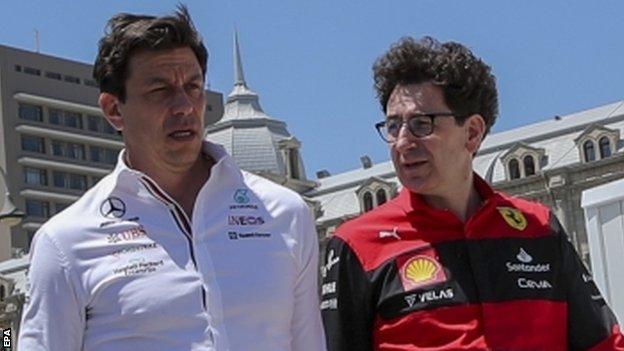
Mercedes team principal Toto Wolff has accused rivals of “pitiful” and “disingenuous” behaviour in the row over cars bouncing in Formula 1.
Wolff had a bust-up with Red Bull’s Christian Horner and Ferrari’s Mattia Binotto in a team principals’ meeting on Saturday at the Canadian Grand Prix.
And afterwards he said they were guilty of “manipulations in the background”.
Binotto said the cars’ behaviour “needs to be improved… [But] it has to be done through the right process”.
Red Bull declined to comment.
The row comes against the backdrop of a controversial intervention from governing body the FIA on the matter, which followed drivers’ requests for it to to take at the previous race in Azerbaijan.
Wolff’s problem was with Horner’s position that it is wrong to penalise teams that have managed to control both bouncing and porpoising – two different but related matters – and with Binotto making what Mercedes regard as procedural objections to attempts to make changes to the cars on the matter.
Wolff’s drivers Lewis Hamilton and George Russell have been among the most outspoken on bouncing because Mercedes are among the teams struggling with it most.
“This is a sport where you’re trying to keep a competitive advantage or gain it but this situation has gone too far,” Wolff said.
“All drivers – at least one in every team – have said they were in pain after Baku, that they have difficulty keeping the car on track or blurred vision.
“And team principals trying to manipulate what is being said in order to keep their competitive advantage and trying to play political games when the FIA tries to come up with a quick solution to at least put the cars in a better position is disingenuous and that’s what I said.
“I’m not only talking about the Mercedes – all of the cars suffered in some way or other in Baku and still do here.
“The car is too stiff or the car is bouncing, whatever you want to call it. This is a joint problem we are having in F1. It’s a design issue that needs to be solved.
“We will have long-term effects that we can’t even judge and at any time this is a safety risk. Then coming up with little manipulations in the background or Chinese whispers or briefing a driver is just pitiful.”
Hamilton said that he has been taking painkillers this week and repeated sessions of physiotherapy, including acupuncture, in an attempt to resolve the back problems the bouncing is causing.
The problem arises from the fact that the new rules introduced this year have reintroduced a phenomenon called ‘ground effect’ into F1.
This forces teams to run the cars with very stiff suspension and close to the ground for maximum performance.
This makes them prone to a phenomenon known as ‘porpoising’ in which a disruption to the underbody airflow leads to a high-frequency bouncing on the straights.
In addition, the stiff suspension and low ride-height can lead to the cars to bounce over bumps.
Russell said: “So many different factors, porpoising is one thing that a lot of teams are on top of but the overall stiffness is just immense. It needs to be addressed. There are things that have been taken off the cars from last year to this to make things simpler. But it has had quite a knock-on effect.”
Those comments are a reference to the simplification of suspension systems on cost grounds this year and other technical changes such as removing devices called “inerters” that settle cars.
Meanwhile, teams have been unhappy with the way the FIA addressed the problem.
It issued a technical directive on Thursday before the Canadian race, which many teams regarded as too-late notice, and with no prior discussion.
In addition, many regarded the ideas in the technical directive aimed at addressing the rules as too complex and unpoliceable, especially a plan to analyse data from the cars to come up with an “aerodynamic oscillation metric” which teams cannot exceed.
There was also criticism of what was perceived as the FIA’s decision to row back on the directive on Friday afternoon in Montreal. The FIA insisted that teams had misinterpreted the directive and that it had always said it was intended as the start of an evaluation process aimed at addressing the issue over a period of time.
Aston Martin team principal Mike Krack described the timing of the directive as “not ideal”, while privately another team boss said the timing was “unbelievable” and that the FIA’s plans would introduce “a ridiculous level of complexity”.
A number of senior figures also said they believed that FIA president Mohammed Ben Sulayem had demanded action was taken immediately so he could be seen as a “friend of the drivers”.
This view comes against a backdrop of general dissatisfaction within F1 about the way the FIA has been conducting itself on a number of issues since Ben Sulayem became president last December.

